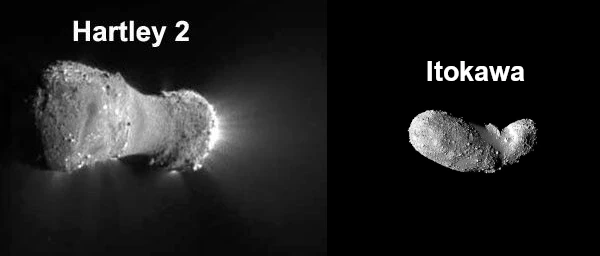
Comet 103P/Hartley 2, flown by the EPOXI probe in 2010, and asteroid 25143 Itokawa, explored by the Japanese Hayabusa mission in 2005, show a surprisingly similar morphology: a bilobed shape evoking a "dog bone" or a celestial peanut. Yet, one is an ice-rich body, periodically active, while the other is a dry rock from the inner Solar System. This morphological resemblance raises fundamental questions about the dynamic and thermal history of small celestial bodies.
Both objects share a low apparent density, indicating they are very porous or even composed of two weakly gravitationally bound independent blocks: they are contact binaries. This structure likely results from low-speed collisions in the final stages of accretion. Could this similar morphogenesis stem from a universal pattern for small bodies? It is plausible, as the aggregation dynamics follow statistical laws governed by relative velocities, dissipated energy, and gravitational re-accumulation.
The Hartley 2-Itokawa case illustrates a blurred boundary between two classes once considered distinct. Observations of extinct comets in the main belt and volatile-rich asteroids (e.g., 24 Themis) suggest that material transfers may have occurred between the Oort Cloud, the Kuiper Belt, and the asteroid belt. Processes of progressive devolatilization, internal heating, or solar erosion can transform a comet into an asteroid.
The joint study of Hartley 2 and Itokawa allows for a better understanding of the morphological diversity of small bodies, expanding the spectrum of forms beyond classical categories. The external similarity masks a difference in spectroscopic composition: Hartley 2 emits jets of CO2 and H2O, while Itokawa is silicatic (type S). However, their shape evokes a dynamics of hierarchical accretion with gravitational reconfiguration after multiple collisions.
| Parameter | Comet Hartley 2 | Asteroid Itokawa | Source |
|---|---|---|---|
| Type | Periodic comet (103P) | S-type asteroid | NASA/JAXA |
| Dimensions | 2.2 × 0.4 km | 535 × 294 × 209 m | EPOXI/Hayabusa |
| Mass | ~3 × 1011 kg | ~3.5 × 1010 kg | NASA/JAXA |
| Average Density | ~200–300 kg/m³ | ~1900 kg/m³ | Groussin et al. (2013) |
| Albedo | 0.028 | 0.29 | Spitzer/IRAS |
| Activity | Yes (gas jets) | No | Optical observations |
Sources: NASA - Hartley 2, JAXA - Itokawa
The strange resemblance between Hartley 2 and Itokawa reminds us that the shape of an object is not enough to deduce its nature or history. These two worlds are the result of different processes: condensation in the cold regions of the Solar System for Hartley 2, and accretion of silicate materials for Itokawa. Yet, they both embody the complexity of small bodies.